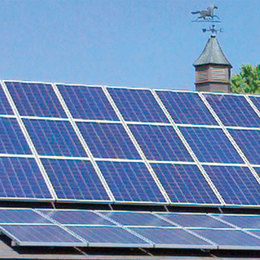
If you’re looking for a five-year return on an an investment that will generate and save you $4,000 every year after that, solar power is the answer. As an added bonus, you’ll reduce your carbon footprint and make a home improvement that will increase your home’s value.
An investment in a solar electric system offered by Wayne-based Aztec Solar Power should generate and save that amount for the owner of an average-sized home, thanks to current government incentives that are aimed at stimulating the economy and reducing our country’s dependence on foreign energy sources by using green, renewable energy to power homes and businesses.
The federal government is now offering a 30 percent federal income tax credit for residences and businesses. Nick Baker, regional sales manager at Aztec Solar Power, further explains that business owners can take advantage of a 30-percent Business Energy Investment Tax Credit or receive a cash Treasury Grant for 30 percent of the system cost.
Business owners can also take advantage of a six-year Modified Accelerated Cost Recovery System deprecation of the system. This can mean a write-off of almost 85 percent of the total system cost.
Incentives are also available on the state level. In May 2009 the Pennsylvania Sunshine Grant was signed into law. This is a funding of $180 million dollars in incentives for homes, businesses and non-profit organizations that wish to use solar energy. The grant offers a rebate to homeowners of $1.75 per watt, for up to 10,000 watts or 10 kW. Systems are rated by their wattage; a panel is rated at 230 watts, for example. In order to calculate a rebate, multiply the wattage of the panel (230 watts) by the amount of the rebate per watt ($1.75). An average home system is 5,000 (5kW) to 7,000 (7kW) watts, which would average a rebate of $8,750 to $12,250.
The Pennsylvania Sunshine Grant is also offering a program aimed at helping businesses that consume a significant amount of power. They will save money by not using any outside electricity. It is tiered at 75 cents for the first 10,000 watts (10 kW); 50 cents for 10,000 to 100,000 watts (100kW); and 25 cents for 100,000 to 200,000 watts (200kW).
Dollars and Sense
If a homeowner has a 5,000-watt system, for example, it should produce 6,000 hours of electricity annually. To calculate the savings, take the number of hours of electricity produced (6,000) and multiply it by the cost per kilowatt hour in southeastern Pennsylvania (16 cents). That amounts to a savings of $960 annually.
Solar Renewable Energy Credits (SREC) are the last piece of the cost recovery puzzle. An SREC is based on the amount of energy produced by the system. Electric companies are required to have a certain amount of renewable and, specifically solar energy, in their generation and distribution portfolios. For every megawatt hour a solar system produces, the owner of the system gets one credit. These credits can be bought and sold on the open market through a broker or aggregator.
Depending on the type of panel, a solar system for the average home will cost between $30,000 to $37,000. To realize your net cost, multiply the cost of the system (for example, $35,000) by the amount of federal tax credit (30 percent), and then multiply the wattage of the system (5,000) by the rebate per watt of the state grant ($1.75). Subtract those two numbers from the cost of the system (say $35,000) and that’s the net cost. In this example, after you’ve received the government’s incentives, you will have paid $15,750 for a solar electric system. A homeowner should save $1,300 a year over 10 years until they break even.
At the current rates, a homeowner can expect to get approximately six credits worth $300 per year. With savings and earnings, that would amount to approximately $3,100.
Next, divide the net cost of a system ($15,750) by the amount of savings and earnings ($3,100), which results in a five-year return on your investment. So every year after that you would make and save $4,000.
Harness the Sun
The only requirements to install a solar electric system are that the panels must face south on a rooftop or open area. Shade trees are problematic. If one panel is blocked, Baker says, the entire system can shut down. The average home would need about 500 square feet, since 1,000 watts equals 100 square feet. If you use a high-efficiency panel, you can reduce it to 300 square feet.
In addition to selling solar electric systems, Aztec Solar Power offers energy management strategies to reduce your overall usage of electricity. Generally, they can offer advice to decrease your energy usage by 10 to 20 percent.
Aztec Solar Power is an off-shoot of Royal Petroleum, a company that has served the Philadelphia area’s energy needs since 1936. All of its design and installation is done in-house. Everyone gets a custom design. “We have access to all products on the market including the most powerful panel available on the market today, sun power,” Baker concludes.
For more information, call 877-SUN-6066 or visit www.AztecSolarPower.com. The Web site contains a solar estimator that will calculate the amount of solar energy available at your location.
Karen Appold is a freelance writer from Royersford. (WriteNowServices.com).


